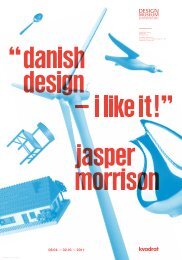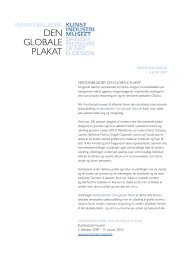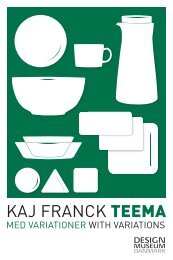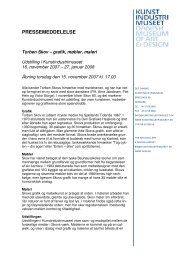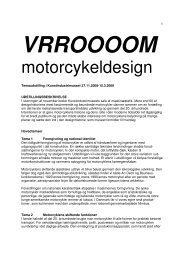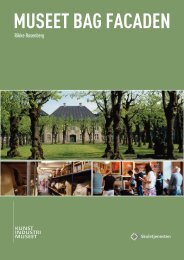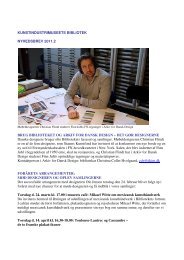Danish design - Designmuseum Danmark
Danish design - Designmuseum Danmark
Danish design - Designmuseum Danmark
Create successful ePaper yourself
Turn your PDF publications into a flip-book with our unique Google optimized e-Paper software.
DANISH<br />
DESIGN<br />
F R O M T H E 2 0 T H C E N T U R Y
The catalog <strong>Danish</strong> Design presents a selection of works from<br />
the <strong>Danish</strong> Museum of Art & Design’s comprehensive<br />
collection of <strong>design</strong> from the 20th Century.<br />
<br />
<br />
<br />
<br />
<br />
<br />
<br />
<br />
<br />
<strong>Danish</strong> <strong>design</strong><br />
From the 20th Century<br />
The <strong>Danish</strong> Museum of Art & Design is the national <strong>Danish</strong> museum<br />
for <strong>design</strong>. The museum was founded in 1890 by the Society of<br />
Industries and the Carlsberg Foundation and since then it has collected<br />
international and <strong>Danish</strong> industrial <strong>design</strong> and craft. The extensive<br />
collections, archives and library at the museum today constitute an<br />
important centre in Denmark for <strong>design</strong> research.<br />
The museum was established with the purpose to bring about a<br />
conception of quality in <strong>design</strong>. The founders wished to inspire <strong>Danish</strong><br />
<strong>design</strong>ers and producers to develop the best industrial products<br />
through analyzing products of quality from different times and places.<br />
At the same time it was the intention to enhance the quality-mindedness<br />
in the <strong>Danish</strong> population. With its always expanding collections<br />
and numerous exhibitions the museum had a central part in the<br />
development of the <strong>Danish</strong> <strong>design</strong> culture during the 20th century.<br />
The <strong>Danish</strong> educational institutions for architecture and <strong>design</strong> have<br />
since the beginning of the 20th century worked closely with the <strong>Danish</strong><br />
Museum of Art & Design and much teaching has been based on the<br />
historical and contemporary objects in the museum. Much of the best<br />
in <strong>Danish</strong> Design has been exhibited at the <strong>Danish</strong> Museum of Art &<br />
Design throughout the century.<br />
<strong>Danish</strong> Design became internationally known, when American<br />
magazines became aware of the new <strong>Danish</strong> furniture, which was<br />
presented at the exhibition of the Copenhagen Cabinet-makers’ Guild<br />
at the museum in 1949. Industrialisation came late to Denmark and<br />
it turned out to be an advantage in the international competition that<br />
the traditions had been upheld. <strong>Danish</strong> <strong>design</strong>ers brought the virtue<br />
of craftsmanship across to industrial <strong>design</strong>, which is worked on with<br />
great understanding of the detail, the proportioning and perception of<br />
the material.<br />
<strong>Danish</strong> <strong>design</strong>ers have always been more engaged in finding practical<br />
shapes that can enhance the utility and aesthetics of existing objects<br />
for everyday use, than in revolutionizing society with utopian ideas and<br />
theoretic artistic manifests. <strong>Danish</strong> industrial <strong>design</strong> is widely inspired<br />
by foreign revolutionary shapes and ideas and improves and refines<br />
these to fit the <strong>Danish</strong> pragmatic and democratic way of life. <strong>Danish</strong><br />
<strong>design</strong>ers of today have to consider the <strong>Danish</strong> <strong>design</strong> tradition, but<br />
they are also part of the global production reality and <strong>design</strong> debate, in<br />
which <strong>design</strong> is oriented towards sustainability as well as free art.<br />
3
Thorvald Bindesbøll (1846-1908)<br />
Label for beer bottle, 1904<br />
Paper<br />
Thorvald Bindesbøll was one of the most original <strong>Danish</strong> craftsmen<br />
and graphic artists and a central figure in the <strong>Danish</strong> Skønvirke<br />
movement around 1900, similar to Art Nouveau, Jugend and Arts and<br />
Crafts movements. Bindesbøll worked in many areas of crafts and<br />
architecture. He was especially known for his powerful and original<br />
ornaments, which he displayed in his ceramic works, in jewellery, book<br />
bindings, silver works and graphics. Many people know Bindesbøll’s<br />
style and expression from the label he <strong>design</strong>ed for the Calsberg Hof<br />
beer, which is still in use and has embellished millions of bottles.<br />
The label tells a story with the little hop flower and the elephant’s<br />
trunk above the word pilsner referring to the four metres tall granite<br />
elephants, who carry the gateway to the brewery buildings in Valby,<br />
Copenhagen.<br />
Knud V. Engelhardt (1882-1931)<br />
Gentofte Municipality Road Signs, 1923<br />
Iron, enamel<br />
4<br />
<br />
Knud Valdemar Engelhardt was educated as an architect and already<br />
during his study years he emerged as the first functionalistic <strong>design</strong>er<br />
in Denmark, when he <strong>design</strong>ed and equipped a new tram type for the<br />
Copenhagen Tramways. All equipment had rounded shapes and his<br />
credo was: “Why add anything that use wears off?” It was however as<br />
a graphics <strong>design</strong>er he mainly became known. I central Copenhagen<br />
his signs (from 1915) with street names in cast bronze letters are<br />
still seen. In Gentofte Municipality North of Copenhagen he is the<br />
originator of the black-enamelled street signs with white letters and the<br />
heart above the letter j as well as the characteristic mushroom shaped<br />
advertising pillars. The rounded solid shapes and easily legible letters<br />
are characteristic for Engelhardt, as well as the heart, which signals<br />
courtesy.<br />
<br />
Poul Henningsen (1894-1967)<br />
Opal glass pendant, 1926<br />
Louis Poulsen & Co<br />
Brass, copper, opal glass blown by mouth<br />
Poul Henningsen – known as PH – was educated as an architect and<br />
was born into a radical <strong>Danish</strong> cultural environment. PH was a multi<br />
artist – architect, painter, light maker, song writer, educator, <strong>design</strong>er<br />
and kite builder. He was a convinced modernist and created a number<br />
of remarkable buildings, furniture and an original light <strong>design</strong> in<br />
cooperation with the lamp makers Louis Poulsen & Co. This led to<br />
the construction of his glare free PH- lamp. To solve the problem of<br />
lighting and create a warm and glare free light with pleasant shade<br />
effect and smooth changes became the driving force in all of PH’s<br />
work as lighting <strong>design</strong>er. PH developed a complete shade system with<br />
varying numbers of shades in different positions, hues and materials.<br />
As a culture critic PH became the provocateur, who attacked thinking in<br />
authoritarian upbringing, Victorianism, sexual denial, conformism and<br />
commercialism. He advocated democratic <strong>design</strong> and a product culture<br />
that could unite beauty and utility.<br />
<br />
5
Kaare Klint (1888-1954)<br />
Buffet, 1929<br />
Rud. Rasmussen Cabinet Makers<br />
Cubamahogany, ebony, brass<br />
Being the first professor in the art of furniture making at the Royal<br />
Academy of Arts in Copenhagen Kaare Klint educated and influenced<br />
a whole generation of <strong>Danish</strong> furniture <strong>design</strong>ers with his pronounced<br />
attitudes and methods. Klint worked systematically, scientifically and<br />
analytically. The furniture should be adapted to man, the room and<br />
their functions – it had to have standard measurements. But contrary<br />
to the modernists of the 1920’s in Central Europe amongst others<br />
he rejected the conception of throwing all experience over board and<br />
submit to an industrial aesthetic with for instance steel. He was a strong<br />
exponent for the new classicistic wave in Denmark in the beginning<br />
of the 20’th century. He continued the <strong>Danish</strong> cabinet-maker tradition<br />
and his <strong>design</strong> as well as his teaching were always based on the study<br />
of older types of furniture, the basic ideas of which could be reused<br />
in the development of furniture for his time. Much of Klint’s furniture<br />
was developed as study projects in cooperation with his students. The<br />
Buffet from1929 is the best known example. Klint and his students<br />
measured a standard service for 12 persons and proportioned the piece<br />
of furniture to fit perfectly to the contents it was to hold. The idiom and<br />
the fine craftsmanship were as many of Klint’s other pieces of furniture<br />
a continuation of the English furniture making in the 18’th century.<br />
Peder Andersen Fisker (1875-1975) & Anders Fisker<br />
The Bumblebee, 1934<br />
Nimbus, Fisker & Nielsen<br />
Metal, rubber, bakelite<br />
6<br />
<br />
Fisker & Nielsen were known for their thoroughly solid vacuum cleaners<br />
in aluminium and marketed under the name ‘Nilfisk’. Their motorcycles<br />
were called ‘Nimbus’ and were as dependable. The most successful<br />
model was produced in the period 1934-1960 and was nicknamed<br />
the Bumblebee because of its humming sound. It was for many years<br />
the preferred motorcycle for the post office, the police and military<br />
in Denmark. It presented itself as a compact whole, all parts were<br />
integrated in the frame, which encompassed the engine and petrol tank<br />
in a characteristic unity. The production was inspired by Henry Ford’s<br />
mass production and the first models were, like Ford’s model T, only<br />
made in black.<br />
<br />
Børge Mogensen (1914-1972)<br />
J39, 1947<br />
FDB Fællesforeningen for <strong>Danmark</strong>s Brugsforeninger<br />
Oak, paper yarn<br />
Børge Mogensen was trained as a cabinet-maker and was a student<br />
of Professor Kaare Klint. He continued Klint’s rational, systematic<br />
and analytic working method. Like Klint he was engaged in further<br />
development of good historical types of furniture, to make them<br />
suitable for the contemporary needs. Mogensen succeeded in bringing<br />
the ideals of craftsmanship across to the industry. As head of the<br />
<strong>design</strong> office of the <strong>Danish</strong> Co-operative Society (FDB) he came up<br />
with the idea for an industrial furniture production that could satisfy the<br />
needs of an average family. Mogensen <strong>design</strong>ed several dining tables<br />
which were inspired by the ascetic furniture of the American Shakers.<br />
He <strong>design</strong>ed a cheap chair for the people based on Kaare Klint’s ‘church<br />
chair’, which was a development of rustic furniture as it is known from<br />
the Mediterranean countries. Mogensen made the chair simple and<br />
cheap to produce and gave it a back rest with good support for the<br />
small of the back.<br />
<br />
7
Hans J. Wegner (1914-2007)<br />
The Round Chair, 1949<br />
Johannes Hansen<br />
Oak, bamboo weave<br />
Hans J. Wegner was trained as a cabinet-maker and had only attended<br />
the School of Arts, Crafts and Design for two years when he was<br />
employed by the architects Arne Jacobsen and Erik Møller. Wegner’s<br />
work, encompassing more than 500 chairs, is a life long endeavour<br />
to understand the nature of wood and exploit its possibilities. His<br />
<strong>design</strong> is characterised by an expressive and sculptural functionalism.<br />
The chairs are often based on different historic types of chair, which<br />
he re-expounded again and again. The shapes of the furniture are<br />
inspired by old work tools like axe handles, scythe handles or oar<br />
blades and their joints constitute practically justified ornaments. The<br />
Round Chair, which became a major work in the international break<br />
through of <strong>Danish</strong> Design in 1949, was based on Wegner’s work with<br />
historic Chinese chairs and the <strong>Danish</strong> tradition for classicistic chairs<br />
with a round back rest. This chair was named ‘The Chair’ in American<br />
magazines and became an important representative for the organic<br />
modernism executed in fine craftsmanship, which made <strong>Danish</strong> Design<br />
internationally known in the 1950’s and -60’s.<br />
8<br />
<br />
Finn Juhl (1912-1989)<br />
Double Chieftain Chair, 1949<br />
Cabinet-maker Niels Vodder<br />
Teak, bent plywood, leather<br />
Finn Juhl was a central exponent for the organic modernism during the<br />
decades after WW2 and furnished several buildings abroad, amongst<br />
others in the UN in New York. Finn Jul was an important figure in the<br />
break through of ‘<strong>Danish</strong> Modern’ in USA and organised a number<br />
of exhibitions of <strong>Danish</strong> Design. His strongly sculptural hand crafted<br />
furniture was inspired by contemporary art, the tools of indigenous<br />
peoples and antique Egyptian furniture. The thin upholstery of the<br />
visually light sofa, the apparently hovering horizontal planes and the<br />
use of teak for indoor furniture became a part of the <strong>Danish</strong> Modern<br />
furniture style, which in fact was initiated by the Chieftain Chair and<br />
sofa in 1949.<br />
Kay Bojesen (1886-1958)<br />
Monkey, 1951<br />
Kay Bojesens Office<br />
Teak, limba<br />
<br />
Kay Bojesen was a silversmith and <strong>design</strong>er. He worked at first in<br />
a personal ‘skønvirke’ ~ Art Nouveau style, which in some ways<br />
is characterised by his learning years at the workshop of Georg<br />
Jensen (1906-10). In the 1930’s he began developing a more simple,<br />
functionalistic style. His silver cutlery set from 1938 won in a stainless<br />
version first prize at the Milano Triennial in 1951 and was named ‘Grand<br />
Prix’. Bojesen is especially known for his <strong>design</strong> of toys in wood, for<br />
instance his guardsman from 1942 and he created a line of craftily<br />
devised animals of which several had movable arms and legs. The<br />
best known is the Monkey from 1951, but also the elephant and the<br />
parrot from the 1950’s are known by several generations and are still in<br />
production. Kay Bojesen also <strong>design</strong>ed furniture for children, jewellery<br />
and objects for the home.<br />
<br />
9
Arne Jacobsen (1902-1971)<br />
The Ant, 3100, 1952<br />
Fritz Hansen<br />
Plywood, cotton, steel tube, rubber hose and rubber glides<br />
Arne Jacobsen graduated as an architect and began to <strong>design</strong><br />
houses in the <strong>Danish</strong> neoclassicistic style, but soon turned towards<br />
the international modernism. His keen sense of detail made him<br />
internationally known as a <strong>design</strong>er. As much as possible he insisted<br />
on <strong>design</strong>ing all furnishing for the houses he built and through this<br />
most of his <strong>design</strong>s were created. The stacking chair The Ant, which<br />
was <strong>design</strong>ed for the canteen of the newly built factory for the drug<br />
company Novo, became the first successful mass-produced chair in<br />
Denmark and it was the first chair with seat and back in one piece.<br />
The <strong>design</strong> was inspired by the experiments made internationally by<br />
<strong>design</strong>ers such as Alvar Aalto and Charles and Ray Eames. The organic<br />
idiom characteristic of its time made The Ant remind one of a sculpture<br />
by Alexander Calder and made it stand out in contrast to Jacobsen’s<br />
architecture. During the next two decades The Ant had six “siblings”<br />
with different shapes for the back rests. The most popular was<br />
‘series 7’. More than seven millions of the series have been produced<br />
till Today.<br />
Henning Koppel (1918-1982)<br />
Fish dish, 1954<br />
Georg Jensen<br />
Sterling silver<br />
10<br />
<br />
Henning Koppel was a <strong>design</strong>er, sculptor and graphics artist and he<br />
was a central exponent for the organic modernism, the style which<br />
developed in the time after WW2. Koppel was educated as a sculptor,<br />
but in 1945 he began to draw silver ware for Georg Jensen, where<br />
he was employed until his death. He shaped great hollowware works<br />
and renewed the tradition in <strong>Danish</strong> silver. These characteristics also<br />
emerge in the large Fish dish from 1954. With its smooth domed lid<br />
and the powerful fish jaws at either end the dish is an expression of a<br />
unique abstract, organic form.<br />
<br />
Sigvard Bernadotte (1907-2002), Acton Bjørn (1910-1992)<br />
The Margrethe Bowl 1954<br />
Rosti<br />
Melamine<br />
In 1949 Bernadotte and Bjørn established the first office for industrial<br />
<strong>design</strong> in Denmark. Bernadotte, who was the son of the king of Sweden,<br />
had drawn silver hollowware for Georg Jensen in a classic idiom and<br />
he had studied industrial <strong>design</strong> with Raymond Loewy in USA. Acton<br />
Bjørn was an architect, but had experience with <strong>design</strong> from his work<br />
with the inside finish of SAS Douglas aircraft. The company <strong>design</strong>ed<br />
everything from plastic utensils for the kitchen to lorries/trucks to<br />
kitchen machines. The <strong>design</strong> of office machines, like calculators and<br />
typewriters, was a major field for the company. The Margrethe Bowl is<br />
their most successful product. It was named after Bernadotte’s niece,<br />
the present queen of Denmark. The simple shape in the new material<br />
melamine quickly showed its practical and aesthetic advantages. The<br />
flat handle level with the edge of the bowl provides a good grip and the<br />
thin edge of the lip makes it easy to pour from. The shape of the bowl<br />
itself fits the stirring spoon or the curve of the beater. A rubber ring was<br />
later added to the bottom of the bowl making it stand securely during<br />
stirring.<br />
<br />
Poul Kjærholm (1929-1980)<br />
ECK22, 1955<br />
E. Kold Christensen<br />
Mat chromium plated flat steel, round pith<br />
Professor Poul Kjærholm had a background as cabinet-maker, but<br />
already during his education as a furniture <strong>design</strong>er he was fascinated<br />
by the steel furniture of the international modernism. Kjærholm strived<br />
towards simple, palpable constructions and focused on the details,<br />
the joints. He considered steel as a natural product of the same value<br />
as wood, which patinates with age. Kjærholm <strong>design</strong>ed the furniture<br />
for large austerely fitted rooms, where it was placed in strict easily<br />
understandable compositions. Kjærholm’s graduation project at the<br />
School of Arts, Crafts and Design was a low chair in flat steel. Like his<br />
teacher Hans J. Wegner he was greatly impressed by Mies van der<br />
Rohe’s Barcelona chair from 1929. In 1955 Kjærholm launched a new<br />
low chair in mat steel on which the steel was put together with visible<br />
Unbrako (Allen) screws and the few parts were laid on top of each<br />
other. The first version of ECK22 was upholstered with Pomeranian<br />
linen or leather. I 1957 the second version with round pith was<br />
launched.<br />
<br />
11
Gertrud Vasegaard (1913-2007)<br />
Tea service, 1956<br />
Bing & Grøndahl<br />
Porcelain<br />
Gertrud Vasegaard is out of one of Denmark’s most well known pottery<br />
families - Hjorth from the island of Bornholm. She was educated at<br />
the School of Arts, Crafts and Design in 1930 and worked Bing &<br />
Grøndahl as well as for Royal Copenhagen, where she <strong>design</strong>ed several<br />
services until she in 1975 created her own workshop and during a<br />
long and rich ceramic life created unica works of singular beauty and<br />
bearing the stamp of uncompromising perfection. The Tea service is<br />
an example of the combination of an impressive craftsmanship and<br />
aesthetic, artistic confidence with its Chinese inspired elegance and<br />
perfection in choice of material, glaze and expression. The eight parts<br />
of the service have each its own shape; the round handle less cup, the<br />
rectangular tea caddy and the hexagonal teapot, but they still interact<br />
like a homogenous unity. The service was already shortly after first<br />
production considered a classic.<br />
LEGO<br />
Lego block, 1958<br />
Plastic<br />
12<br />
<br />
LEGO, with a building block of plastic as its basic element, is an<br />
educational toy system for children. The name LEGO is made up of the<br />
words ‘leg (play) and godt (good)’. The special feature of the system<br />
is that the LEGO block is based on a strict modular system in which all<br />
parts fit together and can be combined in countless ways. The LEGO<br />
system offers unique opportunities for children to play, construct and<br />
experiment. Apart from the toy LEGO A/S has developed the blocks<br />
for other purposes. For instance a series of smaller blocks has been<br />
developed especially for architects. LEGO was founded in 1932 by Ole<br />
Kirk Kristiansen (1891 – 1958), who started up by producing wooden<br />
toys from 1934 under the name LEGO. In 1947 a die casting machine<br />
for plastic was acquired and by 1953 export was gradually established.<br />
With the founder’s son, Godtfred Kirk Kristiansen, the company had its<br />
real breakthrough in 1958 with the patenting of the LEGO block and its<br />
coupling system. The company is continuously expanding its product<br />
programme with new elements and themes.<br />
<br />
Verner Panton (1926-1998)<br />
Panton Chair, 1960 (1967)<br />
Vitra<br />
Plastic<br />
Verner Panton was abroad one of the most acknowledged <strong>Danish</strong><br />
<strong>design</strong>ers. Contrary to his <strong>Danish</strong> colleagues he was not inspired by<br />
historic types of furniture, elegant hand craft and the shapes of nature,<br />
but by the newest technology, consumer culture and the 1960’s<br />
international pop wave. His strong colours and provocative shapes<br />
were perceived as a reckoning with the good taste and social and moral<br />
responsibility in Denmark. A great part of his work were total <strong>design</strong>s.<br />
He arranged complete interiors, where colours, shapes, materials, light<br />
and ornaments dissolved the geometric room into an organic unity.<br />
The Panton Chair fulfils a dream that had been prevailing since the<br />
beginning of the 20’th century when the production of chairs in bent<br />
steel tube without the rear legs began. In the industrial age the goal had<br />
become a mass produced chair in one mould and one material. Panton<br />
became the first to realise the dream of a shell chair cast in plastic in a<br />
mould.<br />
<br />
13
Grete Jalk (1920-2006)<br />
Sløjfestolen, the Bow Chair, easy chair, 1963<br />
PP Jeppesens Møbelfabrik<br />
Laminated, folded wood<br />
Before her education at the School of Arts, Crafts and Design Grete Jalk<br />
had a background as a cabinet maker and <strong>design</strong>ed hand made chairs<br />
as well as industrial furniture and products. She arranged numerous<br />
exhibitions about <strong>design</strong> as well as publishing a large work on the<br />
furniture exhibitions of the Cabinet-Makers’ Guild 1927-1966. Grete<br />
Jalk was a pupil of professor Kaare Klint and was oriented towards the<br />
function and production method of furniture. Amongst other thing she<br />
was preoccupied with exploring the possibilities of laminated wood.<br />
The bow-shaped chair represents culmination of the development of<br />
the bent laminated plywood chairs. The Bow is bent in only one plane,<br />
but the two connected parts make the chair appear to be stressed to<br />
the point, which one could fear might be the limit. The chair does not<br />
ascribe to an organic form like the earlier bent plywood chairs, but is on<br />
the contrary very true to its construction and looks exactly as what it is<br />
– a chair for resting – nothing else. Grete Jalk deigned at the same time<br />
a set of three nesting tables, which repeat the curves of the chair.<br />
Gunnar Aagaard Andersen (1919-1982)<br />
Polyether chair, 1964-65<br />
Dansk Polyether Industri<br />
Polyurethane foam<br />
14<br />
<br />
Gunnar Aagaard Andersen was an architect, sculptor, painter and<br />
<strong>design</strong>er of furniture, textiles, wallpaper etc. He was one of the post<br />
war most experimenting multi-artists in Denmark. As a visual artist he<br />
worked with a concrete/constructivistic idiom. Gunnar Aagaard began<br />
to experiment with furniture from the 1950’s and developed a series of<br />
remarkable furniture that challenged the ability of the cabinet-makers<br />
and the shape ability of the wood. Inspired by pop art and the abstract<br />
expressionism he created the foam chair – Portrait of My Mother’s<br />
Chesterfield – from polyurethane foam. The whipped cream-like<br />
material could be poured out in layers and in this way he managed to<br />
create a chair in one continuous process and in one unbroken shape<br />
without the use of moulds. The chair is a piece of furniture as well as<br />
an object of art. The humour of the chair, its savageness and radicalism<br />
have provoked many in the <strong>Danish</strong> <strong>design</strong> environment, but they have<br />
also inspired younger <strong>design</strong>ers to launch themselves into border<br />
breaking projects.<br />
<br />
Nanna Ditzel (1923-2005)<br />
Hallingdal, 1965<br />
Kvadrat Ltd<br />
Wool, viscose in linen binding<br />
357a-h/2003<br />
The furniture <strong>design</strong>er Nana Ditzel <strong>design</strong>ed several textiles amongst<br />
these the upholstery material Hallingdal, which has been produced by<br />
Kvadrat Ltd. since 1965. It is still in use for furnishing public areas that<br />
demand strength for wear and tear. DSB, the <strong>Danish</strong> railways, used<br />
the material for the seats in the IC3 trains. Hallingdal is produced in a<br />
mixture of wool and viscose. The wool retains the dirt repelling qualities<br />
and adds elasticity while the viscose gives brilliance to the colour.<br />
During all the years Hallingdal has been woven in 200 different plain or<br />
shimmering colour variations that portray the prevalent changing colour<br />
tendencies.<br />
Nanna Ditzel (1923-2005)<br />
Hallingdal, 1965<br />
Kvadrat<br />
Wool, viscose in linen binding<br />
The furniture <strong>design</strong>er Nanna Ditzel <strong>design</strong>ed several textiles amongst<br />
these the upholstery material Hallingdal, which has been produced by<br />
Kvadrat since 1965. It is still in use for furnishing public areas that<br />
demand strength for wear and tear. DSB, the <strong>Danish</strong> railways, used<br />
the material for the seats in the IC3 trains. Hallingdal is produced in a<br />
mixture of wool and viscose. The wool retains the dirt repelling qualities<br />
and adds elasticity while the viscose gives brilliance to the colour.<br />
During all the years Hallingdal has been woven in 200 different plain or<br />
shimmering colour variations that portray the prevalent changing colour<br />
tendencies.<br />
<br />
15
Jacob Jensen (f.1926)<br />
Beomaster 1900, 1976<br />
Bang & Olufsen (B&O)<br />
Teak, extruded aluminium, plastic, steel<br />
Jacob Jensen was an interior decorator educated at the furniture<br />
department of the School of Arts, Crafts and Design. He was employed<br />
by Bernadotte and Bjørn, the first office in Scandinavia for industrial<br />
<strong>design</strong>, from 1951 to 1958, when he opened his own office. The<br />
stereo radio Beomaster 1900 presents itself as an extract of the <strong>design</strong><br />
profile Jacob Jensen created for B&O during the 1970’s. The long,<br />
flat and top operated instrument with sunken operating buttons is a<br />
simple and rationally well worked out operating surface. Secondary<br />
adjustments are hidden under a lid. The choice of colours black and<br />
white (aluminium) signal sense and asceticism, but also a seductive<br />
magic that comes forth when the invisible black displays light up or<br />
when the lid is opened to reveal the secret ‘cockpit’ of the instrument.<br />
Jacob Jensen transformed the international modernism known from<br />
architecture into instrument <strong>design</strong>.<br />
Erik Magnussen (f.1940)<br />
Thermos, 1976<br />
Stelton<br />
Plastic, glass<br />
16<br />
<br />
Erik Magnussen was educated as a potter at the School of Arts,<br />
Crafts and Design and worked for a number of years for the porcelain<br />
factory Bing & Grøndahl. His industrial <strong>design</strong>s are far-reaching,<br />
from furniture to the public space to articles for everyday use. The<br />
shape of Magnussen’s <strong>design</strong> is always determined by the function<br />
of the product and its production, with emphasis on quality and<br />
inexpensiveness. The simple basic shapes and solutions consisting<br />
of a few parts joined in the most appropriate way are refined with<br />
consideration for the properties of the materials. His Thermos Jug<br />
consists of seven parts, which are clicked together. This makes the jug<br />
cheap and easy to clean. The jug is assembled at the top and contrary<br />
to other thermos jugs it has no opening at the bottom. If the gasket<br />
in the top leaks the coffee does not seep out onto the table, but stays<br />
in the outer shell. It can be handled by one hand as the lid tilts when<br />
pouring.<br />
<br />
Grethe Meyer (1918-2008)<br />
Ildpot (Firepot), 1976<br />
Den kgl. Porcelainsfabrik<br />
Stoneware<br />
Grethe Meyer was educated as an architect and already during her study<br />
years she showed distinct skills for a scientific approach to architecture.<br />
She published the book “Byggebogen” for which she had collected<br />
much relevant information about building and she collaborated<br />
with the furniture architect Børge Mogensen on the development of<br />
‘Building-cupboards for the home’. I her large production of objects<br />
she emphasized utility value and production suitability. With the dinner<br />
set Firepot Grete Meyer combined the knowledge of the counteraction<br />
between angles and shapes with the foremost pottery insight and all<br />
parts were drawn with the knowledge she had of standardisation of<br />
the components for the home. The dinner set is produced with the<br />
technique ‘jiggering’ in unglazed stoneware that is patinated by use<br />
and by which the visual impression is naturally enhanced. All parts<br />
can be stacked and be used for several functions. The set fulfilled the<br />
contemporary wish for cooking utensils that could go directly from the<br />
stove to the table and finally into the freezer.<br />
Ursula Munch-Petersen (f.1937)<br />
Ursula, 1993<br />
Den kgl. Porcelainsfabrik<br />
Faience<br />
<br />
Ursula Munch-Petersen is a descendant of the pottery dynasty Hjorth<br />
of the island of Bornholm. She is educated at the School of Arts, Crafts<br />
and Design and her work is often inspired by popular simple artefacts.<br />
The Ursula service set exemplifies an example of her interest in<br />
taxonomy, the classification of living and extinct organisms. The beaked<br />
pitchers and bowls, that are part of the set, are a result of Ursula<br />
Munch-Petersen’s work with formtypologies. Several of the parts of<br />
the set have deliberately been made distinctively larger than necessary,<br />
many shapes are asymmetric and the choice of colours distances itself<br />
from the neutral earth colours that were often seen on other services of<br />
that time. Ursula is not a complete set but rather a palette of choices for<br />
combination. Ursula Munch-Petersen herself calls it a family of cups,<br />
jugs and bowls. The service does not look like an industrially produced<br />
set and exactly therein lies the strength of modern craft.<br />
<br />
17
Nanna Ditzel (1923-2005)<br />
Trinidad, 1993<br />
Fredericia Stolefabrik<br />
Cherry, chomium-plated steel tubes<br />
Trinidad is a stackable chair <strong>design</strong>ed by Nana Ditzel, who was<br />
educated as a cabinet-maker and furniture <strong>design</strong>er. She was one of<br />
the few women, who managed to penetrate the very male dominated<br />
furniture business. She was inspired by new materials and had great<br />
insight in production methods. Nana Ditzel used for example the first<br />
CNC milling machine in Denmark to cut Trinidad’s characteristic thin<br />
lines in the seat and back of the chair. The <strong>design</strong> is inspired by the<br />
colonial jigsaw works in the Caribbean islands, where she went on<br />
vacation several times. With Trinidad Ditzel managed to create a new<br />
<strong>Danish</strong> breakthrough for the pressed wood. While Arne Jacobsen with<br />
his simple and naked Ant chair wished to create lightness as not to<br />
disturb the eye wandering through the room, Ditzel made the chair itself<br />
transparent. In this way Trinidad became visually even lighter, and at<br />
the same time more decorative and expressive.<br />
Ole Jensen (f.1985)<br />
Ole, 1997-98<br />
Den kgl. Porcelainsfabrik<br />
China (porcelain)<br />
18<br />
<br />
Ole Jensen was educated at the School of Arts, Crafts and Design<br />
as well as at the Royal Academy of Arts. He has added humour, play<br />
and artistic experience to the otherwise rational basic <strong>Danish</strong> <strong>design</strong><br />
tradition, but he emphasizes the primary functions of objects in his<br />
<strong>design</strong>s. Ole does not in the traditional way consist of plates, cups,<br />
saucers and dishes, but consists rather of those parts of a service and<br />
utensils that have appealed to the <strong>design</strong>er like the lemonsqueezer,<br />
mugs, colander, and bowls. The forms are close to Japanese and<br />
traditional Nordic pottery. Ole is a functional series with humour added<br />
to help turn everyday into a play.<br />
<br />
Hans Sandgren Jacobsen (f.1963)<br />
Gallery, 1998<br />
Frederica Furniture<br />
Ash plywood, steel tube<br />
Hans Sandgren Jacobsen was trained as a cabinetmaker and <strong>design</strong>er.<br />
He has worked in Japan and been attached to Nanna Ditzel’s office for<br />
a number of years and continues to work within the tradition of the<br />
transparent constructions of <strong>Danish</strong> Design. Gallery is the first <strong>design</strong><br />
from the time, when he started his own office. It is a very simple, bent<br />
plywood stool developed at the request of Gl. Strand for their exhibition<br />
rooms. The stool is made of 10 layers of rectangular plywood bent as<br />
much as possible and held together by two steel tubes. The <strong>design</strong><br />
is based on a long <strong>Danish</strong> tradition for bent plywood furniture, which<br />
encompasses Grete Jalk’s Sløjfestol (the Bow Chair) (1963), Nanna<br />
Ditzel’s Trinidad (1998), and Arne Jacobsen’s series of chairs<br />
(1951-68).<br />
<br />
19
Cecilie Manz (f.1972)<br />
‘Hochacht‘, ladder chair, 1999<br />
Jacob Trolle Rasmussen<br />
Ash wood<br />
Cecilie Manz is educated at the <strong>Danish</strong> Design School and her works<br />
cover a wide field from furniture and product <strong>design</strong> to jewellery<br />
and sculpture. Her <strong>design</strong>s express simplicity and lightness and she<br />
attempts to find the essence of the function of the product. Hochacht<br />
is in the category of furniture that - apart from the possibility to rest<br />
- invites to think about furniture – their presentation and function. With<br />
this piece of furniture Cecilie Manz enrols into a humoristic, functional<br />
tradition, which Kay Bojesen advocated with his mantra ‘Lines must<br />
smile’. The duality of the ‘ladder’, in which the work function has been<br />
changed to a place of rest without being too comfortable, is a good<br />
example of Cecilie Manz’s approach to <strong>design</strong>, which never becomes<br />
puristic functional but on the contrary possess humour, minimalistic<br />
aesthetic, surprise elements – and above all high quality and utility.<br />
20<br />
<br />
Louise Campbell (f. 1970)<br />
Casual Cupboard, 2000<br />
Bahnsen Collection<br />
Ash plywood, elastic band, Velcro<br />
Louise Cambell was educated at the London College of Furniture and<br />
at the <strong>Danish</strong> Design School. Although she is considered an heir to<br />
the continuation of the <strong>Danish</strong> furniture tradition her furniture can be<br />
perceived as a clash with the <strong>Danish</strong> <strong>design</strong> tradition based on the<br />
function of objects. Her <strong>design</strong>s are very experimenting with materials<br />
and shapes. Several of her works are on the border-line between <strong>design</strong><br />
and art and they have a femininely decorative and graphic expression.<br />
Casual Cupboard draws on the classic <strong>Danish</strong> Design tradition for<br />
bent plywood. The cupboard is a new and flexible way to envision<br />
storage furniture. It can easily be moved around in the house and it<br />
stands or hangs both vertically and horizontally or be used as a bench.<br />
It contradicts the conception that clothes must be hidden and folded<br />
perfectly when it is placed in the cupboard.<br />
Kaspar Salto (f. 1967)<br />
Ice, 2002<br />
Fritz Hansen<br />
Aluminium, plastic<br />
<br />
Kaspar Salto was educated cabinet-maker and graduated from the<br />
<strong>Danish</strong> Design School in 1994. He belongs to a group of younger<br />
<strong>Danish</strong> <strong>design</strong>ers, who continue the 20th century’s <strong>Danish</strong> furniture<br />
school, which amongst other things emphasizes good craftsmanship,<br />
high quality execution and thorough proportioning and detailing of the<br />
shapes. Salto’s Ice is a modern mass produced chair in aluminium<br />
and plastic, <strong>design</strong>ed for both outdoor and indoor use for instance at<br />
the dining table, for conferences or at cafés. It has a light and strong<br />
construction, which easily can be taken apart in order to have the<br />
materials melted for recycling. The pronounced graphic expression of<br />
the chair resembles the back it is meant to support.<br />
<br />
21
Johannes Foersom (f.1936) og Peter Hiort-Lorenzen (f.1943)<br />
Imprint, chair, 2006<br />
Lammhults AB, Svweden<br />
Pressede cellulose fibre mats, powder coated steel, plastic<br />
glides<br />
The <strong>Danish</strong> furniture <strong>design</strong>ers Johannes Foersom and Peter Hiort-<br />
Lorenzen are cabinet-makers and were educated at the Furniture<br />
Department of the <strong>Danish</strong> Design School. Together they have run a<br />
<strong>design</strong> office since 1977 and <strong>design</strong>ed and developed furniture and<br />
other products using advantageous production processes. They<br />
have for a number of years experimented with new technologies and<br />
materials and through these created new solutions for shapes. The<br />
shell chair Imprint from 2005 is produced from cellulose fibre mats, a<br />
new and environmentally friendly natural material. The flecked look of<br />
the chairs is the result of various plant parts like bark and pine needles<br />
being added to the fibre mass. The <strong>design</strong> enters into a long tradition<br />
of fibre chairs pressed into shape, which dates back to Charles Eames’<br />
fibre glass chair (1950)<br />
Boris Berlin (f.1953), Poul Christiansen (f.1947)<br />
Komplot Design<br />
Nobody, chair, 2007<br />
Hay (Nordifa, Halmstad, Sweden)<br />
Synthetic felt (polyester/pet felt)<br />
22<br />
<br />
The <strong>design</strong> duo ‘Komplot,’ Boris Berlin and Poul Christiansen work<br />
with graphics, product <strong>design</strong> and furniture <strong>design</strong>. Their idiom and<br />
ideas are far-reaching, from the poetic conceptual and humoristic to<br />
the profoundly objective, functional and minimalistic. They often take<br />
in historic and foreign products for renewed consideration and their<br />
modus operandi is highly analytical and experimenting and based<br />
on new technologies. The chair Nobody is made of recycled PET felt<br />
made from used soda water bottles. Heavy upholstery has never been<br />
really acceptable in the modernism movement because it hides the<br />
construction. With the chair Nobody everything has been turned upside<br />
down as the upholstery itself has become the bearing construction.<br />
The body of the chair has been removed – only the comfort providing<br />
cover remains. The material challenges us: ‘Can that soft material really<br />
support?’ The chair is hyper modernistic – created in one mould and<br />
one material meant for mass production.




